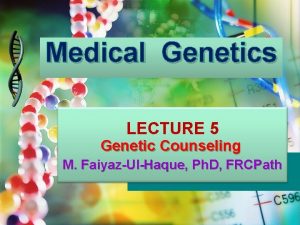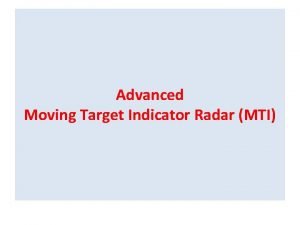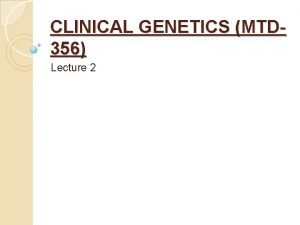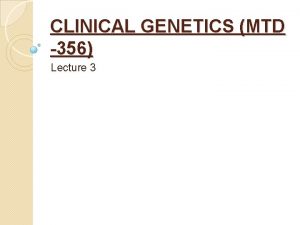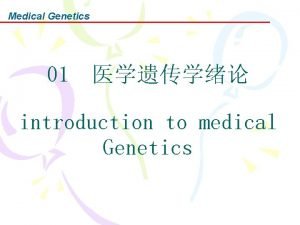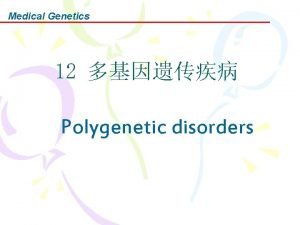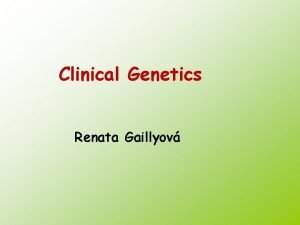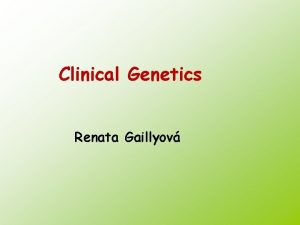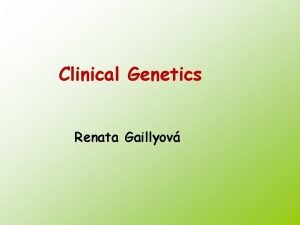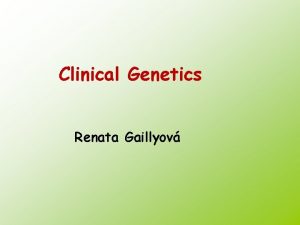CLINICAL GENETICS MTD 356 Lecture 1 Introduction Medical














- Slides: 14

CLINICAL GENETICS (MTD 356) Lecture 1 Introduction

Medical Genetics �Apply genetics in medical care and involves the diagnosis and management of hereditary disorders. �It covers clinical practice of physicians, genetic counselors, and nutritionists, clinical diagnostic laboratory activities, and research into the causes and inheritance of genetic disorders.

�Why different from General/human Genetics? �Genetics of eye colour? �Causes and inheritance of genetics disorder �diagnosis, management, and counseling of individuals with genetic disorders

Subspecialties of Medical Genetics �Clinical genetics is the practice of clinical medicine with particular attention to hereditary disorders. Referrals are made to genetics clinics for a variety of reasons, including birthdefects, developmentaldelay, a utism, epilepsy, short stature, etc. �Metabolic (or biochemical) genetics involves the diagnosis and management of inborn errors of metabolism in which patients have enzymatic deficiencies that perturb biochemical pathways involved in metabolism of carbohydrates, amino acids, and lipids.

�Cytogenetics is the study of chromosomes and chromosome abnormalities. While cytogenetics historically relied on microscopy to analyze chromosomes, new molecular technologies such as array comparative genomic hybridization are now becoming widely used. �Molecular genetics involves the discovery of and laboratory testing for DNA mutations that underlie many single gene disorders. �Mitochondrial genetics concerns the diagnosis and management of mitochondrial disorders, which have a molecular basis but often result in biochemical abnormalities due to deficient energy production.

Genetic Counseling �the process of providing information about genetic conditions, diagnostic testing, and risks in other family members, within the framework of nondirective counseling. �Genetic counselors are non-physician members of the medical genetics team who specialize in family risk assessment and counseling of patients regarding genetic disorders. �The precise role of the genetic counselor varies somewhat depending on the

Current practice The clinical setting in which patients are evaluated determines the scope of practice, diagnostic, and therapeutic interventions. For the purposes of general discussion, the typical encounters between patients and genetic practitioners may involve: � Referral to an out-patient genetics clinic (pediatric, adult, or combined) or an in-hospital consultation, most often for diagnostic evaluation. � Specialty genetics clinics focusing on management of inborn errors of metabolism, skeletal dysplasia, or lysosomal storage diseases.

�Referral for counseling in a prenatal genetics clinic to discuss risks to the pregnancy (advanced maternal age, teratogen exposure, family history of a genetic disease), test results (abnormal maternal serum screen, abnormal ultrasound), and/or options for prenatal diagnosis (typically amniocentesis or chorionic villus sampling). �Multidisciplinary specialty clinics that include a clinical geneticist or genetic counselor (cancer genetics, cardiovascular genetics, craniofacial or cleft lip/palate, hearing loss clinics, muscular dystrophy/neurodegenerative disorder clinics).

Diagnostic evaluation �Each patient undergoes a diagnostic evaluation tailored to their own particular presenting signs and symptoms. �The geneticist establishes a differential diagnosis and recommends appropriate testing. These tests might evaluate for chromosomal disorders, inborn errors of metabolism, or single gene disorders.

Chromosome studies � used in the general genetics clinic to determine a cause for developmental delay/mental retardation, birth defects, dysmorphic features, and/or autism. Chromosome analysis is also performed in the prenatal setting to determine whether a fetus is affected with aneuploidy or other chromosome rearrangements. Finally, chromosome abnormalities are often detected in cancer samples. A large number of different methods have been developed for chromosome analysis: � Chromosome analysis using a karyotype involves special stains that generate light and dark bands, allowing identification of each chromosome under a microscope. � Fluorescence in situ hybridization (FISH) involves fluorescent labeling of probes that bind to specific DNA sequences, used for identifying aneuploidy, genomic deletions or duplications, characterizing chromosomal translocations and determining the origin ofring chromosomes.

� Chromosome painting is a technique that uses fluorescent probes specific for each chromosome to differentially label each chromosome. This technique is more often used in cancer cytogenetics, where complex chromosome rearrangements can occur. � Array comparative genomic hybridization is a new molecular technique that involves hybridization of an individual DNA sample to a glass slide or microarray chip containing molecular probes (ranging from large ~200 kb bacterial artificial chromosomes to small oligonucleotides) that represent unique regions of the genome. This method is particularly sensitive for detection of genomic gains or losses across the genome but does not detect balanced translocations or distinguish the location of duplicated genetic material (for example, a tandem duplication versus an insertional duplication).

Basic metabolic studies Biochemical studies are performed to screen for imbalances of metabolites in the bodily fluid, usually the blood (plasma/serum) or urine, but also in cerebrospinal fluid (CSF). Specific tests of enzyme function (either in leukocytes, skin fibroblasts, liver, or muscle) are also employed under certain circumstances. In the US, the newborn screen incorporates biochemical tests to screen for treatable conditions such as galactosemia and phenylketonuria (PKU). Patients suspected to have a metabolic condition might undergo the following tests: � Quantitative amino acid analysis is typically performed using the ninhydrin reaction, followed by liquid chromatography to measure the amount of amino acid in the sample (either urine, plasma/serum, or CSF). Measurement of amino acids in plasma or serum is used in the evaluation of disorders of amino acid metabolism such as urea cycle disorders, maple syrup urine disease, and PKU. Measurement of amino acids in urine can be useful in the diagnosis of cystinuria or renal Fanconi syndrome as can be seen incystinosis. � Urine organic acid analysis can be either performed using quantitative or qualitative methods, but in either case the test is used to detect the excretion of abnormal organic acids. These compounds are normally produced during bodily metabolism of amino acids and odd-chain fatty acids, but accumulate in patients with certain metabolic conditions. �

� The acylcarnitine combination profile detects compounds such as organic acids and fatty acids conjugated to carnitine. The test is used for detection of disorders involving fatty acid metabolism, including MCAD. � Pyruvate and lactate are byproducts of normal metabolism, particularly during anaerobic metabolism. These compounds normally accumulate during exercise or ischemia, but are also elevated in patients with disorders of pyruvate metabolism or mitochondrial disorders. � Ammonia is an end product of amino acid metabolism and is converted in the liver to urea through a series of enzymatic reactions termed the urea cycle. Elevated ammonia can therefore be detected in patients with urea cycle disorders, as well as other conditions involving liver failure. � Enzyme testing is performed for a wide range of metabolic disorders to confirm a diagnosis suspected based on screening tests.

Molecular Genetics � DNA sequencing is used to directly analyze the genomic DNA sequence of a particular gene. In general, only the parts of the gene that code for the expressed protein (exons) and small amounts of the flanking untranslated regions and introns are analyzed. Therefore, although these tests are highly specific and sensitive, they do not routinely identify all of the mutations that could cause disease. � DNA methylation analysis is used to diagnose certain genetic disorders that are caused by disruptions of epigenetic mechanisms such as genomic imprinting and uniparental disomy. � Southern blotting is an early technique basic on detection of fragments of DNA separated by size through gel electrophoresis and detected using radiolabeled probes. This test was routinely used to detect deletions or duplications in conditions such as Duchenne muscular dystrophy but is being replaced by high-resolution array comparative genomic hybridization techniques. Southern blotting is still useful in the diagnosis of disorders caused by trinucleotide repeats. � Short tandem repeats are unique markers that can be used to determine haplotypes and are used in identity testing for maternal
